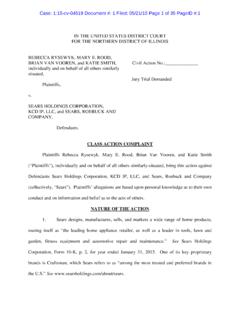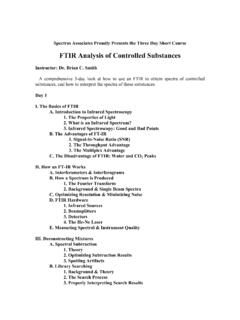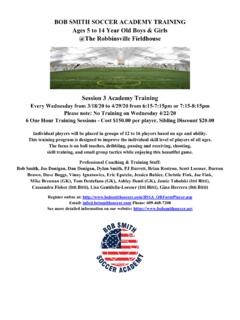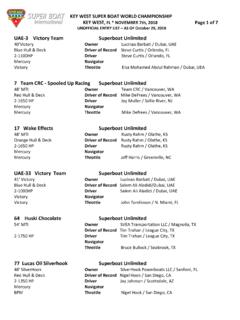Transcription of I III Brian Pearce I J Ws- lLL II
1 ~LHandloader 2-Iull~ , (left) was lengthened tocreate Special (middle), which ultimatelyled to the (right). Brian Pearcen spite of being nearly a c n-IJtury old, the .44 Smith&W s-son Special is still one ofIour finest and most versat Ierevolver cartridges, at least ifhandloaded. Introduced in 1907 8along with the first Smith&Wess nN-Frame New Century, commo lynicknamed the "Triple Lock," t eSpecial was created by lengtheni gthe .44 Russian case from .97 in hto sometimes conflict, but it appears tlatearly ammunition was loaded with 26 grains ofblack powder to drive a 246-grain leadroundnose bullet around 780 fps. A smoke-less load appeared at about the same timethat drove the above bullet 750 fps. Withthe obvious potential of smokeless pow-ders to boost velocity above the black-powloads, it remains a mystery why the factories diload it to something around 900 or 950 fps.
2 (Anpropriate charge of Unique powder, availabledming this era, could drive bullets past 900 fpswhile staying within recommended pressurelimits.)34,!IIIIIII:~IIIlfIn spite of today's new factory loads, the Specialcan still be improved through handloading to in-crease power, accuracy and versatility in smallerand lighter guns than the .44 Magnum. Those whounderstand and appreciate the virtues of the .44 Special and the great sixguns chambered for it areindeed sixgun the two decades following the .44 Special'sintroduction,many recognized that it could behandloaded with appropriate smokeless powders toachieve substantially greater power than anycommercial cartridge of the era. The car-tridge's best-known advocate was ElmerKeith. Keith was in a unique position totry sixgun loads on game ranging fromstringy jackrabbits to elk and was a promoterKeith found he could drivea250-grain bullet 1,200 fps fromarevolver fitted witha5'A-inch long-range six gunning as the ultimate testfor accuracy.
3 During the 1920s he developedhis own line of sixgun bullets with .44-caliberLyman mould 429421 (weighing 250 grains) becom-ing possibly the most popular bullet of all time inthe .44 the early 1930s, with the advent of Hercules(now Alliant) 2400 powder, Keith found he couldIdrive a 250-grain bullet 1,200 fps from a revolver fit-ted with a 5%-inch barrel. For nearly 30 years, hewrote about the virtues of heavy .44 Special loadsfor hunting, accuracy and defense and urged am-munition companies to introduce his load. TheKeith load used grains of 2400 behind his 250-:::eptember 2 "'"FEDERALH andloader 236-litali~:.i,'Ii wma-'4 SWl.~ 4 SWHaving used the Special for avariety of applications, includingtarget and hunting, I appreciatethe blend of caliber, bullet weight,velocity and comparatively.
4 338 Winchester Magnum. Mtergetting above the bear on thesteep hillside, a 250-grain .44 Spe-cial bullet was planted squarelybetween his shoulders, cuttingthe spine and exiting betweenthe front legs. Several muledeer have fallen to the same bul-lets that were traveling 900 to980 spite of this modest velocity,bullets completely penetrate onbroadside lung shots, and deerusually drop within 20 to 50yards. I once shot a mountain lionin the chest, as it faced me, usinga .44 Special fitted with a 5Y2-inchbarrel loaded with 250-grainKeith-style bullets at 950 fps. Theslug traveled straight as an arrowlengthwise, then broke the back-bone and exited. Total penetra-tion was around 30 44 offerssufficient performancefor hunting big , the original 246-grainroundnose remains available, but somecompanies have increased veloc-ity using lighter bullets.
5 BuffaloBore offersa255-grain cast SWCat1,000 fps for post-World War /Iguns only. Right, the original .44 Special 246-grain factory load(left) is advertisedatabout 755fps. The handload containsa250-grain Keith-style cast bulletloadedto1,200 Smith&Wesson and Colt tooffer revolvers so newcomers, Skeeter's stan-dard .44 Special load consistedof grains of Alliant Uniquecombined with the 250-grainLyman cast bullet 429421 atabout 950 .44 Special offers sufficientperformancefor hunting biggame with Keith-style cast semi-wadcutter (SWC) bullets drivenfrom 900 to 1,200 fps. A numberof years ago, I planted two 250-grain cast bullets (from Lymanmould 429421) through the lungsof a bull elk at over 100 were driven 1,200 fps froma Colt New Frontier with a 7~-inch barrel. Both bullets exitedthe offside, and the bull ran 20 or30 feet before going same year I trailed a blackbear that had been wounded ;m}~IE CARli~144MG144SP-j6~~~p 18612 Ili"illjl' IIU"'.
6 S~cll ~iohlel "'18R,mREDDINGI~~::~~""""""'"1 """"'"I44 5P''HIAl. (:l)MFlH SUgrain cast bullet, but factorieswere concerned about revolverssafely handling the 25,000 psipressures this load generated. In1953 Keith visited the Remingtonand Smith&Wesson plants andurged them to bring out a mod-ern magnum .44-caliber sixgunby lengthening the Special inch. Keith's wishes finallybecame a reality in 1955/56 withthe introduction of the .44 Rem-ington .44 Magnum was a signifi-cant development, particularlyfor hunters, but the revolverswere larger and heavier thanSmith&Wesson and Colt SingleAction .44 Specials, which wereso trim and handy for belt , with the exception ofSmith&Wesson's Model 629 Mountain Gun, most .44 Mag-nums are larger and heavier thanever, leaving a legitimate placefor the Special.
7 One prominentgun writer, the late Skeeter Skel-ton, recognized the virtues ofthis round and played a majorrole in its continued popular-ity. During the 1970s and 1980s,he convinced the head dies are suit-able for loading the "!!ilIIilillI''Iunder SAAMI recommendationof 15,500psi. We can only specu-late'why this load has never beenupdated to give just a bit morevelocity, but it is likely linked tothe steels used in the early S&WNew Century an effort to boost theSpecial's velocity, Winches-ter offers a 200-grain Sil-vertip hollowpoint (HP),Federal a 200-grain leadSWC-HP and Remington a 200-grain lead SWC, each driven 900fps. One can't help but noticethe ballistic similarity of theabove loads to the .44 WCF in arevolver, a cartridge that gener-roundnose bullet driven an ad-vertised 755 fps. Regardless ofthe advertised velocities, in re-cent decades it is difficult to finda given lot number of ammuni-tion from either company thatwill go much faster than 700 fpsfrom revolvers with 4- to 71f-inchbarrels.
8 In fact, a trained eye ingood light can usually watchthese bullets in flight. I don'tknow what the pressures are run-ning, but they are low and has always hadareputation for being .44 Special has always hada reputation for being accurate. Itis doubtful it is more accuratethan other similar straight-walledrevolver cartridges, as long asthey are loaded correctly, but ittakes a rather unreasonable loadto make it misbehave. If careis taken in the selection ofcomponents and in assem-bling ammunition, it oftenproduces extreme spreads of20 fps or less for 10-shot loads most shooters arefamiliar with as offered by Win-chester and Remington for thepast 97 years include the previ-ously mentioned 246-grain leadTable Special "Category One"(15,500 psi or less)extremebulletpowderchargevelocitysp read(grains)(grains)(Ips)(Ips)200 RCBS 44-200-FN castRed recoil-cowboy actionIUniversal ,05529240 Hornady lead Lyman 429383 cast round as 1908 factory small game small game load250 Lyman 429421 general : A Smith&Wesson New Century (Triple Lock) Targetrevolverwith a 6lf-inch barrel was used to fire theaboveloads.
9 Winchestercases and CCI 300 primers used Speer Gold Dot , ,012240 Hornady lead or leading may occur249 Lyman 429383 cast round , small game load250 Lyman 429421 Lyman 429244 GCPower : A Freedom Arms Model 1997 with a 4X-inch barrel was used in aI/the above loads. Winchester cases and eel 300 primers used Alert - Publisher cannal accepl respansibilily far errars in published laad had a good reputation for de-fense and even hunting gamewithin practical Bore Ammunition offerstwo loads designed specificallyfor American manufactured .44 Special revolvers produced afterWorld they exceedSAAMI pressure recommenda-Before retiring to the loadingbench, it's important to under-stand safe working pressure lim-its for a given gun. It seemsprudent to divide popular .44 Special revolvers into categories:the first consisting of standardpressure loads that don't exceed15,500psi, the second category isfor guns that can digest loadsthat develop up to 22,000 psi,while the third category is heldto a maximum of 25,000 of cast bullets was used in compiling load data.
10 Lefttoright:RCBS 44-200-FN, Lyman 429215220 grains, Lyman429383 245grains,Lyman429421250 grains, RCBS 44-250-K255grains, Lyman 429244255 grains and Dry Creek SWC 307 'Itions, they are safe in appropriaterevolvers. The first load drives a185-grain jacketed hollowpoint(JHP) 1,150 fps, while the secondpushes a 255-grain cast SWC1,000 fps. In spite of the factoriesgenerally using non-canisterpowders, their ballistics can none-theless be duplicated because a gun has digesteda given load doesn't mean it willstand a steady diet of such. Whena gun is fired continuously withloads that are stressing it, metalcan become fatigued and eventu-ally becomes dangerous. Thepoint being, loads must have asufficient margin of safety toallow a reasonable life span forAbove, jacketed .44-caliber , . inch are suitable for the.








